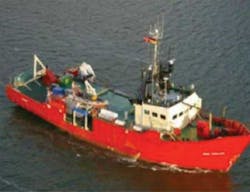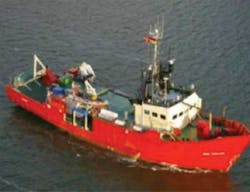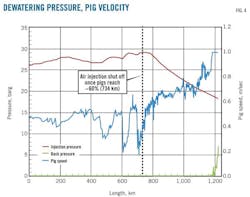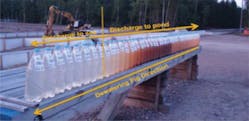Marco Casirati
Jarleiv Maribu
Nord Stream AG
Zug, Switzerland
John Grover
Daniel Fehnert
Baker Hughes PPS
Dubai
As subsea hydrocarbon pipelines have grown in scale, plans for their precommissioning have been incorporated early in project development. The Nord Stream natural gas pipeline, crossing the Baltic Sea from Vyborg, Russia, to Lubmin (near Greifswald), Germany, successfully used this approach.
Part 1 of this article (OGJ, May 6, 2013, pp. 100) detailed the planning, engineering, and preparation for Nord Stream's precommissioning. This second part continues this discussion before looking at relevant field experience gained during project execution.
Sealing pigs
All pigs were specifically designed and fabricated for the Nord Stream project. Nord Stream conducted market surveys and conceptual studies with three different pig vendors, one of which tested a prototype pig. Tests included pressures required for initiation, running, restarting forward and reverse, and flipping the discs. The resulting recommendations and proven field experience from earlier projects provided the basis for the final pig selection. Several concepts were evaluated but discarded, including lightweight pig bodies and the use of wheels.
During the production and assembly phase, each pig was subject to extensive quality checks. Before final delivery, each pig was again checked and measured to make certain it was delivered in accordance with specifications.
FCG pigs
Flooding, cleaning, and gauging (FCG) pig designs required that they displace the air with water, ensuring an air content of less than 0.2% in volume, and pass a 97% nominal internal diameter gauge plate through the pipeline without damage. They also had to be able to remove as much construction debris as possible from the pipeline.
The selected design was a conventional bidirectional pig with four guiding discs, three sealing discs, and one gauge plate on each pig. All pigs also carried magnets and were designed to carry a transponder for tracking. One pig carried a smart gauge plate through each pipeline section.
Dewatering pigs
Dewatering pigs were to separate the desalination slugs and remove as much water as possible before starting the drying operation. These pigs had to perform over the 1,224-km (760-mile) full length of the pipeline, a dewatering length that had never been done before. Careful selection of pig dimensions ensured the discs did not wear out (stiff discs) during the distance or lose contact with the pipe wall (soft discs) because of aquaplaning. The discs needed to have correct hardness, wear properties, flexibility, and contact forces with the pipe wall.
The selected dewatering pig was also bidirectional with four guiding discs and four sealing discs. All pigs carried rare-earth magnets for local pig tracking and were designed to carry a transponder for global pig tracking.
Sealing tools
Sealing tools used during hyperbaric tie-ins prevent water in the welding area. A minimum of one tool on each side of the weld is required. To provide a sufficient level of protection with respect to pressure variations (tidal variations, atmospheric pressure variations), the sealing tool must be able to hold a certain pressure without any movement.
This tool is a further development of the traditional spheres used in earlier projects. It contains two sealing elements (tires) mounted on a bidirectional pig with guiding discs to achieve long-distance wear resistance after completion of the tie-in. Nord Stream sealing tools' nominal designed break-loose pressure was 1.5 bar. The tools also had to be capable of travelling up to 675 km for removal after weld completion. A total of four tools were used.
Smart gauge
The third pig in each of the FCG pig trains carried a smart gauge plate to identify any gauge plate damage and assist in locating pipeline defects. The system, once activated, could be interrogated either subsea while travelling through the pipeline, or when at rest in the receivers. The smart gauge records the first damage event and communicates the time of event through the pipe wall when interrogated without physically removing the pigs from the head.
Pig tracking
Accurate pig tracking is essential to confirm the location of the pigs when launched, received, and in transit. It provides increased operational confidence and was required on the Nord Stream project to divert any discolored water in front of each pig into the settling pond.
Acoustic transponders provided global pig tracking when the pig train was moving or stationary. The magnets, included in all bidirectional pigs, provided the local pig tracking when passing magnetic pig detectors. All FCG pigs and Pigs 1-3 of the dewatering train included active acoustic transponders. These allowed each pig to be individually identified and its distance from the pig tracking vessel calculated.
The duration of the pig runs and the time between the subsea deployments in the laydown heads and the actual run required a long battery life and a delayed start mechanism. Acoustic transponders provided an excellent solution because they only emit an acoustic signal when requested and can be left in sleep mode for more than a year before use.
In addition to the active acoustic transponders, magnets activated detectors subsea and onshore to confirm the passage of each of the pigs out of the launchers and into the receivers on each section. A pig tracking vessel followed each pig train, checking both the smart gauge and pig position from launch to receipt on the FCG, sealing tools, and dewatering pigs (Fig. 1).
Tracking the interface between water and air by plotting the velocity as measured at the discharge outlet in Russia provided an additional way of tracking the dewatering train. The water column in front of this pig (Fig. 2) will produce an outlet flow and velocity proportional to the pipeline profile (height of liquid column).
The interface pig will always be at the last plotted position on the velocity graph. Comparing it with the pipeline profile shows the pig's location. This method is accurate as long as the pig train is in a reasonably good condition so that little or no air bypasses the pigs. The velocity graph slowly trending away from the pipeline profile shows the pig train losing sealing integrity due to large amounts of air bypassing the pigs. This method may also be used for pig train quality control as it progresses through the pipeline. The information received helps engineers at the receiving end better prepare for what to expect; air in front of train, two-phase flow, etc.
Water treatment selection
Given the volumes involved, seawater was the only practical option as a water source. Seawater had to be adequately treated before injection into the pipelines, satisfying two conflicting requirements: line integrity (protecting the inner surfaces of the pipelines) and compliance with international and local environmental standards for the direct discharge of precommissioning waters back into the sea.
Testing of the treatment approach and specifications to the maximum possible extent in laboratory and field tests occurred before submittal to the environmental agencies for water discharge permits. Nord Stream carried out studies on precommissioning water in two distinct phases:
• In preparation for the precommissioning operations, over a period of about 2 years, to test and select the most appropriate treatment and obtain the discharge approval by the agencies.
• During precommissioning, in particular during the FCG operations and during the dewatering of the pipelines, to monitor and document the results of the selected and approved treatment approach.
Seawater treatment has a two-fold objective in terms of pipeline integrity: avoiding oxygen-induced corrosion (OIC) and minimizing the risk of microbiologically induced corrosion (MIC). Adding oxygen-depleting agents to the seawater (oxygen scavengers, typically sodium hydrogen sulfite) meets the first objective.
The offshore industry uses several different methods for MIC control, ranging from strong biocides, to the inhibition of bacterial activity by pH control of seawater, to ultraviolet (UV) light. Nord Stream chose not to use biocides, and pH control had to be carefully evaluated for possible carbonate precipitate formation, which could prove problematic for pigs travelling during the dewatering phases.
The three alternative treatments of natural seawater investigated were doses of:
• Oxygen scavenger (OS).
• OS and pH control with caustic soda (NaOH).
• OS and biocide (Gluteraldehyde), for comparison purposes only.
Natural seawater (without any treatment) acted as the control.
The 2009-10 testing program, in cooperation with Finnish company Ramboll OY, included:
• Seasonal seawater sampling and analysis at sites intended for water uptake (KP297 and KP675), and at a site representing KP0.
• Bench-scale laboratory tests.
• Pilot plant-scale tests for precipitation potential of treatment option.
• Laboratory-scale medium and long-term corrosion tests (LCT), reproducing anticipated conditions inside the pipelines and various residence times of the treated seawater in the lines (between 1 and 10 months).
• Full-scale testing (FST), whereby sections of pipeline were filled with treated and non-treated seawater, deployed subsea and left on the sea bottom for 6-12 months (Fig 3).
Seawaters collected at KP0 underwent FST and LCT, with results then factored for seawater at KP297 and KP675 using scientific judgment based on detailed knowledge of the physical-chemical characteristics of the water at the three locations.
The "no treatment" option was ruled out based on possible long residence time in the pipeline. The combination of OS dosage and pH control using NaOH gave no advantage over OS dosage, except for the planned 2-4 month residence time of the seawater in the pipelines during precommissioning.
Pilot scale precipitation tests showed that calcium carbonate precipitates inside the pipelines could add to the project's risk because of the resulting amounts of sludge to be moved along the pipelines during dewatering.
Nord Stream selected the OS-only option for treatment of seawater, adding UV light treatment before filling the pipelines with water as an extra safety contingency. Comparatively high numbers of sulfate-reducing bacteria (SRB) in the seawater sampled at KP297 and KP675 during spring and summer prompted the UV usage. SRB can lead to MIC.
Noise
The German landfall site has stringent noise emission limits of 65 db (day) and 55 db (night) at the closest dwelling. The local marina was within 500 m of the compressor spread. Sound-proofing all supplied equipment to 76 db at 7 m ensured noise emission limits were met without any additional special sound barrier.
Results
The subsea heads, hot stabs, and pig tracking system worked flawlessly during FCGT operations. All FCG pigs performed as expected and no damage was observed. The water filtration, additive system, and pumping spread operated consistently at or above their specified duty levels.
Air content confirmed to be well within the Det Norske Veritas (DNV) requirement of less than 0.2% demonstrated the flooding operation's success. A final cleaning run removed less than 2 kg of construction debris in each section. Iron oxide and small amounts of sand and some red-colored dust were also removed.
Gauging plates confirmed the internal diameter to be within design requirements. Out of six smart gauge runs, one gave a damage indication (which proved to be false). Acceptance of pressure test operations occurred after only hours of pressure stabilization before the mandatory 24-hr holding period. The accompanying table shows a summary of the pressure test data for Pipeline 1. Pipeline 2 had similar results.
Favorable spring weather conditions, with temperatures similar at the surface and at the bottom of the Baltic Sea, were one of the main reasons for the quick and successful pressure test.
Dewatering
Temporary onshore pig traps, together with a temporary 48-in. diameter valve, resulted in smooth and controlled dewatering. This made it easier to control the operation and to keep water and air separated during launching of the pig train. Pig 4 provided a perfect barrier between desalination water and the air.
The compressor spread and dryers, as well as all support systems, met or exceeded their specified duties during the operation. Air injections ceased as planned when the dewatering pig train had travelled 60% of the pipeline length, with remaining pig travel driven by the expanding air. This saved fuel and minimized depressurization requirements after receipt of the pig train at the Russian end.
The pig-tracking vessel followed the different pigs all the way to the Russian coast. The two sets of sealing tools (one set from KP 297 and one from KP 675) arrived first, then the dewatering train. Diverting the water in front of each pig to the settling pond required accurate pig tracking. Fig. 4 shows the dewatering pressure and pig velocity, with Fig. 2 showing additional details with respect to pipeline profile and pig velocity.
Receipt of the pig train included checking the desalination water's chloride content. Analysis demonstrated final chloride content was well below the specified 200-ppm limit. Water volume in front of the swabbing pigs was small. Experience from Pipeline 1 (little water) allowed the flow in front of the swabbing pigs to be routed through the silencers for Pipeline 2.
The amount of water in front of the swabbing pigs measured less than 1 cu m. This was due to good pigs, internal coating, and smooth operations. The discharge control valve only operated once, toward the end of dewatering to maintain maximum 1 m/sec velocity.
The desalination pigs showed little wear after travelling 1,224 km. The swabbing pigs showed more wear, but still maintained sealing integrity, indicating that they had been running mostly dry and confirming the results. Drying Pipeline 1 took 18 days, including a 24-hr soak period. The soak period confirmed an atmospheric water dewpoint of less than -35° C., allowing Pipeline 2 to be dried to less than -35° C. without a soak period.
Drying removed 4.5 cu m of water, based on dew point readings and air volume, corresponding to a water film thickness of 1 µm on the pipe wall and demonstrating the best dewatering results ever achieved. Recorded gas dewpoint levels confirmed dryness post-commissioning.
Nitrogen
Avoiding explosive mixtures in the pipeline during gas fill (as set out by DNV OS-F101) required an inert gas as a barrier between the air and the natural gas in the pipeline. Nitrogen packing differed between Lines 1 and 2. Line 1 was completely filled from Germany with 99.9% pure nitrogen. Line 2 was partially filled from Russia (gas filling end) using a 99.9% pure nitrogen batch equal to 10% of the pipeline volume.
The mixing zone between air and nitrogen measured about 1.5 km for both pipelines. The mixing zone between nitrogen and gas was 2-3 km. Maintaining the interface velocity above the critical minimum was an important component of obtaining these results.
Water treatment
The SCV with seawater injection pumps installed carried out treatment of seawater, pumping precommissioning water into the pipelines at KP297 and KP675. Water treatment included:
• Filtration through 200 µm and 50 µm cartridge filters.
• Online injection of the oxygen scavenger (OS), a commercial solution of sodium bisulfite and iron-based catalyst.
• UV-light treatment.
A fully equipped laboratory aboard the SCV obtained the key analytical parameters of seawater for control of the treatment operations. Daily adjustments to metered OS doses matched the measured oxygen concentrations of filtered seawater. The results of the test program set the OS dose rate at its stoichiometric value, 6.5 mg OS/mg O2.
Dissolved oxygen concentrations in the filtered seawater were generally at saturation values of 12.5-15.0 mg/l. Over-saturation also occurred at times. The potential environmental impact of oxygen-depleted water at the discharge location received particular attention. A special water diffuser was designed and installed to achieve a high re-oxygenation effect in the immediate proximity of the discharge point, a requirement of the water discharge permit released by the Russian authorities. Field measurements carried out during dewatering confirmed the effectiveness of the diffuser.
A UV treatment unit also installed on the precommissioning vessel had a design killing-rate of more than 99% of the initial bacteria count at effective UV dosages of 40-60 millijoule/sq cm. Bacteriological analysis was carried out in the laboratory aboard the SCV during the FCG operations for both total anaerobic and total aerobic bacteria before and after the UV package.
The calculated killing rates for anaerobic bacteria were generally in line with expectations. Results and observations confirmed water treatment achieved project targets. Measurements found no measurable impact on the marine environment at the discharge site and pipeline integrity was confirmed.
Environmental
The water treatment program allowed discharge of almost all water directly into the sea. Discolored water in front of each pig was captured and settled before discharge. Water stored in the settlement pond was discharged to sea through filters after no less than 24 hr. All water discharged to sea was clean and contained no oxygen.
Discharge occurred 600 m offshore through a diffuser nozzle to ensure rapid oxygenation of the water. Any oxygen levels greater than 7 ppm were well within the 100-m from the diffuser required by regulations. Fig. 5 shows discolored water as sampled during operations.
A third party monitored noise in Germany. The compressor spread complied fully with the project's stringent noise limits. Sound proofing all individual units also improved the working environment for operational personnel and improved safety as normal verbal communication was possible within the compressor spread.







